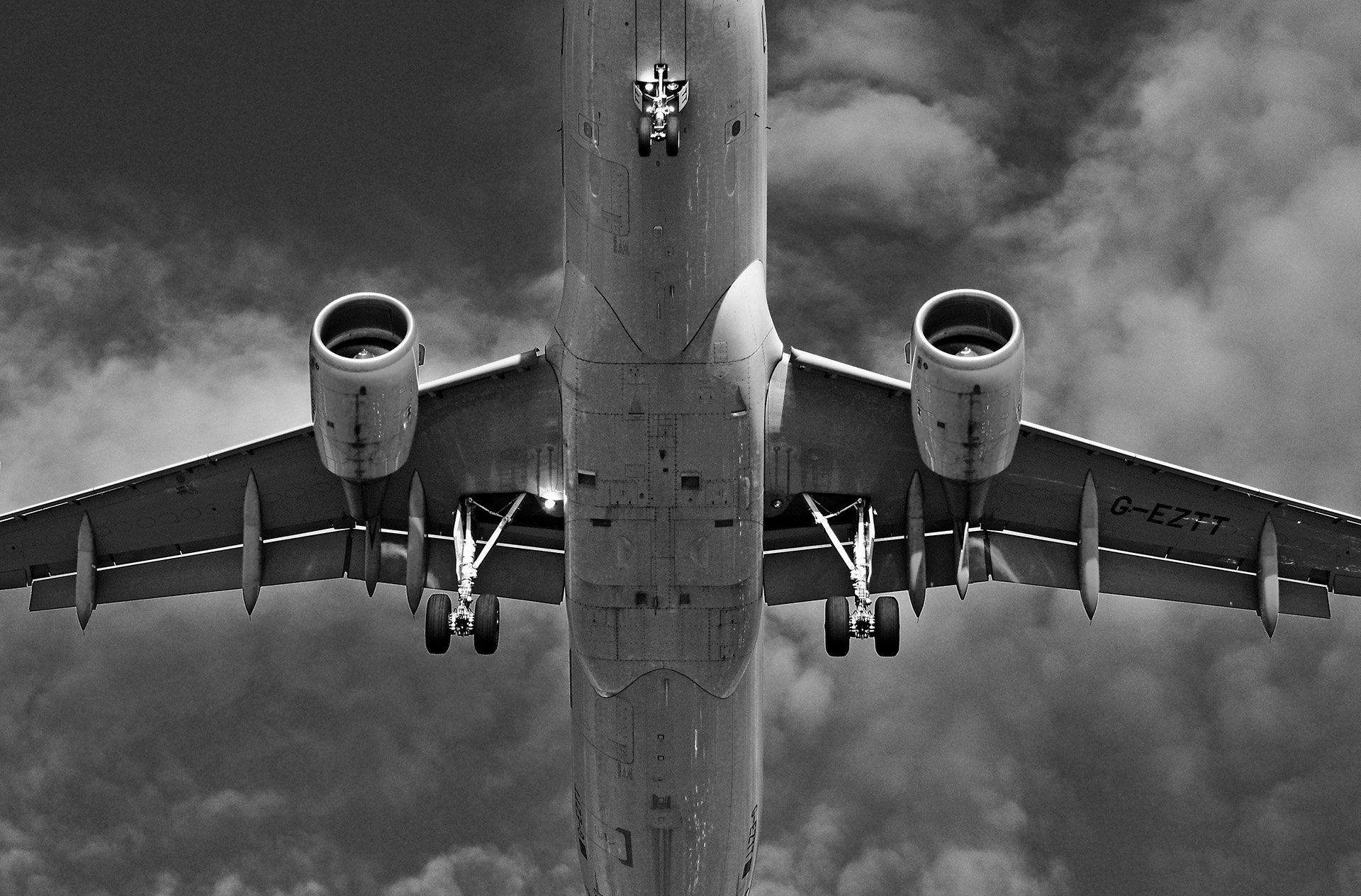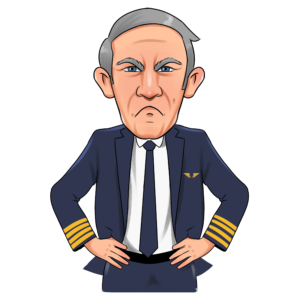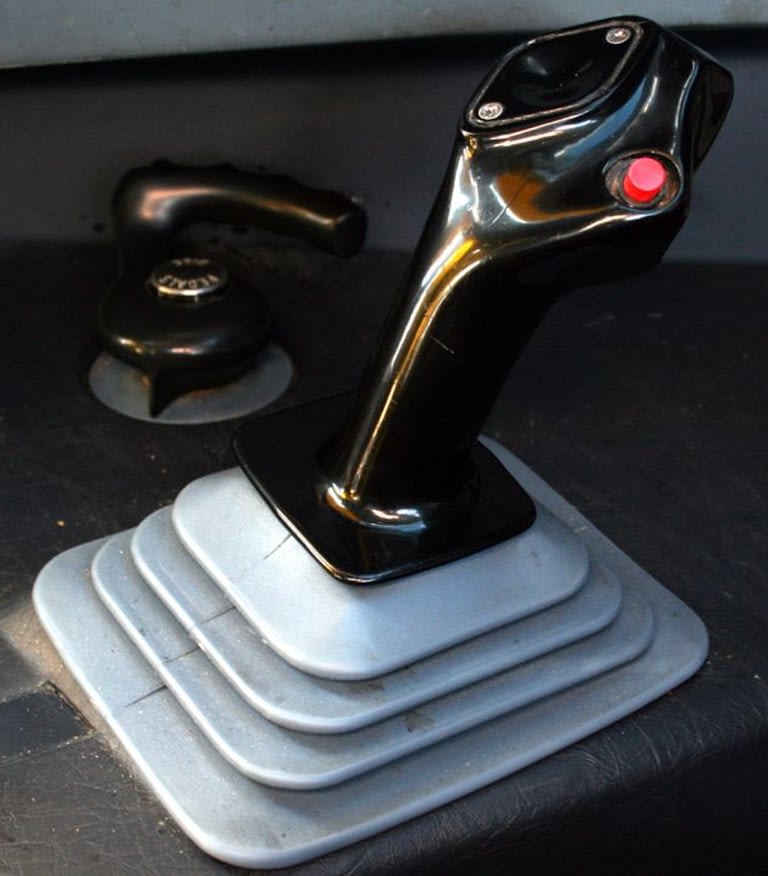Many people think that the major feature of a fly by wire system is the lack of any mechanical connection between the stick and the control surface, and while this isn’t wrong, there’s a bit more to it.
Fly by wire is a collection of features, all of which, at the end of the day, allow the pilot to control the aircraft.
So let’s start with the idea that fly by wire is just another way of controlling an aircraft.
See, while all aeroplanes are subject to the same laws of physics when a pilot makes a given control input, conventional aircraft and FBW aircraft respond differently.
Could you fly the Airbus without knowing anything about the details of its FBW system?
Yes, you could and the beauty of the machine’s design is that you could probably do it quite well.
In fact, there are thousands of pilots doing just that every day!
But, having a clear grasp of Airbus fly by wire logic and philosophy will ensure that you truly understand the impact of every control input that you make.
And that’s pretty important.
Learning basic aerodynamics can be a drag.
But having a basic understanding of Airbus aerodynamics will help you appreciate the A320’s design philosophy and make it easier for you to understand just what the Airbus is doing.
But first, in order to have something we can compare the Airbus to, let’s begin with a quick review of some of the more important aerodynamics involved in controlling a conventional aircraft.
One of the biggest differences between the Airbus and a conventional aircraft is the way in which each type responds to a pilot’s control input.
Remember that control of an aircraft’s flight path is achieved by altering the shape of a control surface so that it can be deflected into the airstream.
This is the whole purpose of ailerons on a wing, elevators on the horizontal stabilizer and the rudder.
Now, in a conventional aircraft, when you make a control input there are a few things going on:
- First, you are directly ordering the related control surface to move. (For example, when you pull back on the yoke, the elevators move.
- Secondly, just how much that control surface moves, is directly proportional to the amount of control input you make. Pull back a little and the surfaces move a little. Pull back a lot and they move a lot. However, the force required to move that surface a given amount will change with the aircraft’s speed and altitude. This last point is pretty subtle, but it’s important.
Let’s see what it’s all about.

Ready for your next Checkride?
Probably not as ready as you should be.
Certainly not as ready as you could be.
Click here to find out more about the world’s first and finest, complete emergency management system designed especially for the A320.
Let’s first look at how SPEED affects control surface movement.
An aeroplane has a wide range of speeds and can go fast, slow or anything in between.
And whenever we make a given AMOUNT of control deflection, it will produce a different result depending on the current speed.
Why is this so?
Well, at low speeds there isn’t much air flowing over the wing.
Although the controls are easy to deflect, they need to be deflected more to achieve a given level of performance.
You’ve felt this sort of “sloppy” control force during slow flight.
However, the exact opposite is true at high speeds.
At high speed, the airflow over the wing is increased and although the controls are now harder to deflect, they don’t need to be deflected as much to achieve a given level of performance.
At these higher speeds, the aircraft now feels “tighter” and more responsive.
Next, let’s consider the effects of ALTITUDE.
When you are at a higher altitude, deflecting a control surface by a given AMOUNT is easier than it is at a lower altitude.
This is because the thinner air results in less aerodynamic damping, which allows the control surface to move more easily.
The end result is that for a given deflection of a control surface, the aircraft response is faster at a higher altitude than it is at a lower altitude.
This can make it much easier to over-control a conventional aircraft at high altitude.
So, the takeaway here is that in a conventional aircraft, changes in speed and altitude can change the way a control surface “feels” to a pilot.
But Airbus engineers wanted something very different.
Airbus engineers wanted an aeroplane where a pilot could consistently obtain the same response from a given control input, regardless of changes in speed, altitude, gross weight or CG.
Airbus engineers wanted an aeroplane that always “feels” the same.
And this required the power of an FBW system.So let’s do a quick recap and summarize the big ideas here.
As we’ve seen, when flying a conventional aircraft, you order the control surfaces to move.
How far they move and the force required to do so, changes depending on the conditions at hand.
Thus, in a conventional aircraft, a given amount of control deflection will result in a different aircraft response, depending on the speed, altitude, GW and CG.
Think of what it’s like to fly a GPWS manoeuvre.In a conventional aircraft, this is generally achieved by trying to fly the stick-shaker.
It’s a very tricky thing to do as the pitch must continually be adjusted and re-assessed.
Too much pitch and you get too close to the stall.Not enough and you’re sacrificing much-needed performance and that hill gets closer and closer!
In a conventional aircraft, you are essentially moving a control surface and then assessing the resulting performance.
The Airbus is different.
When you make a control input, instead of ordering a specific amount of control surface deflection, you are ordering a performance.
The computers and software do all the hard work to figure out just how much control surface deflection is required to achieve the performance you’ve requested.
This is much easier because you simply need to know what performance you want, rather than how to go about getting it!
Let’s look back to the GPWS manoeuvre we previously discussed.
In a conventional aircraft, the pilot has to figure out what control inputs will give him a maximum performance climb.
In the A320, the pilot simply has to know that he needs to get the fuck away from the ground and can pull full back stick, immediately.
The flight control computers move and adjust the elevators to provide the maximum allowable performance.
In other words, the computers dial up the best possible aerodynamic performance while protecting you from ripping the tail off and stalling at the same time.
Allow me to say it once again, in the A320, when you make a control input, instead of ordering a specific amount of control surface deflection, you are actually ordering a performance.
The computers and software do all the hard work and figure out just how much control surface deflection is required to achieve the performance you’ve requested.
Let’s see just how this works.
On the A320, when you move the sidestick, your inputs are first sent to the Flight Control Computers.
This means that the computers process your inputs, before delivering them to the actual control surface.
This computer processing is where a good bit of the magic happens.
Remember that a computer can be programmed to behave in any way that the designers see fit and the Airbus has plenty of interesting shit cooked into it.
For example, in the A320, a push or pull on the sidestick does not command a directly proportional movement of the elevator.
Instead, a push or pull on the sidestick orders a “G” load.
I may have lost you there, so before we go any further, let’s first make sure we understand the terminology correctly.
A “G” is a measurement of force.
It is equal to the force of gravity pushing down on a stationary object on the earth’s surface.
An aircraft flying level experiences 1 G.
An aircraft in a steady climb or descent experiences 1 G.
Extra G forces can be created by changing the aircraft’s velocity or its direction of motion, through climbing, descending or turning.
Positive G’s make you feel heavier and usually occur during the initial pull in a steep climb or a tight turn.
Negative G’s make you feel lighter and are usually the result of a push.
So let’s imagine an A320 with the sidestick in the neutral position, with no push or pull.
In this case, a neutral sidestick orders 1G flight, with a zero pitch rate, so that even though you aren’t even touching the stick, the Airbus computers will order and continually adjust the elevators to maintain flight at 1 G.
I’ll say that again, so you can really dig it.
Even though you aren’t even touching the stick, the Airbus computers will order and continually adjust the elevators to maintain flight at 1 G.
That means that the elevators can and will move by themselves, even in manual flight with the stick-free, if necessary, to maintain 1 G flight.
If you pitch up or down, and then release the stick, the pitch attitude will remain steady at the point at which you released the stick and the aircraft will maintain the flight path even if the thrust, speed or configuration changes.
This equates to a very stable flight path.
So that’s stick-free.
What happens if you push or pull the stick?
Well, a push or pull on the sidestick selects a particular G load.
If you pull back on the stick, you order a G load greater than 1 G.
And if you push on the stick, you order a G load of less than 1 G.
Because most pilots are not used to flying G, all of this G-load talk can get a bit confusing and it’s probably easier to think of the sidestick as a way to select a pitch rate when you are at low speed and a G-load when you’re at higher speeds.
This is more in line with the way pilots actually feel the movement of an aircraft.
See, a control input at low speed doesn’t create much g-loading for the rate of pitch change, so at low speed, a pilot is generally thinking in terms of a pitch rate when she makes a stick input.
But at high speed, a control input will make you feel a much larger g-force for the same amount of pitch rate.
Let’s break this down a bit.
At a slow speed, if you gently pull back on the stick, and just hold this slight back pressure, the aircraft will keep pitching up slowly.
In reality, you’ve asked the computers to command a G loading which is just a bit higher than 1 G.
However, as far as you’re concerned, you’ll see and feel this as a pitch rate.
When you reach your desired pitch attitude, simply let go of the stick and the nose will stay right where you left it, as stick-free, the aircraft automatically flies a 1 G path.
On the other hand, hauling full back stick will select the aircraft’s maximum allowable G-loading and the aircraft will pitch up rapidly.
Just like before, this pitching up will continue until you let go of the stick or until the pitch, speed, G loading or alpha, reaches a computer imposed limit.
These computer imposed limits are also known as protections and we’ll talk about them in more detail later.
The exact opposite is true when you push on the stick.
Pushing the stick forward very slightly will command a G loading just a bit less than 1 G and the nose will start pitching down slowly.
Pushing the stick rapidly to its full forward position will select the aircraft maximum allowable negative G loading and the aircraft will pitch down rapidly.
Regardless of what you do, when you let go and the stick is neutral, the nose will stay right where you left it and the computers will move the surfaces to maintain flight at 1 G.
This is very different from the conventional aircraft that we discussed earlier and something that all Airbus pilots must both recognise and appreciate.
Remember that in the conventional aircraft, moving the stick:
Directly ordered the related control surface to move and just how much that control surface moved, was directly proportional to the amount of control input that was made.
In addition, the force required to move that surface a given amount, was dependent on the aircraft’s speed and altitude.
In the A320:
- A stick input in pitch sends a signal to the flight control computers to command a performance based on a particular “G” loading.
- The human pilot perceives this as a pitch rate at low speeds and a G load at higher speeds.
- Stick-free the aircraft continually adjusts the control surfaces to maintain flight at 1 G and in doing so, it ends up correcting for small changes in thrust, speed and atmospheric disturbances.
So, there you go.
By now, you should have a much better understanding of the design goals of the Airbus fly-by-wire system.
Not only will this increase your operational intelligence, but it can help you to truly grasp the benefits and limitations of the A320.
Be kind, be smart, fly well.
Until next time…




Thanks for the post!